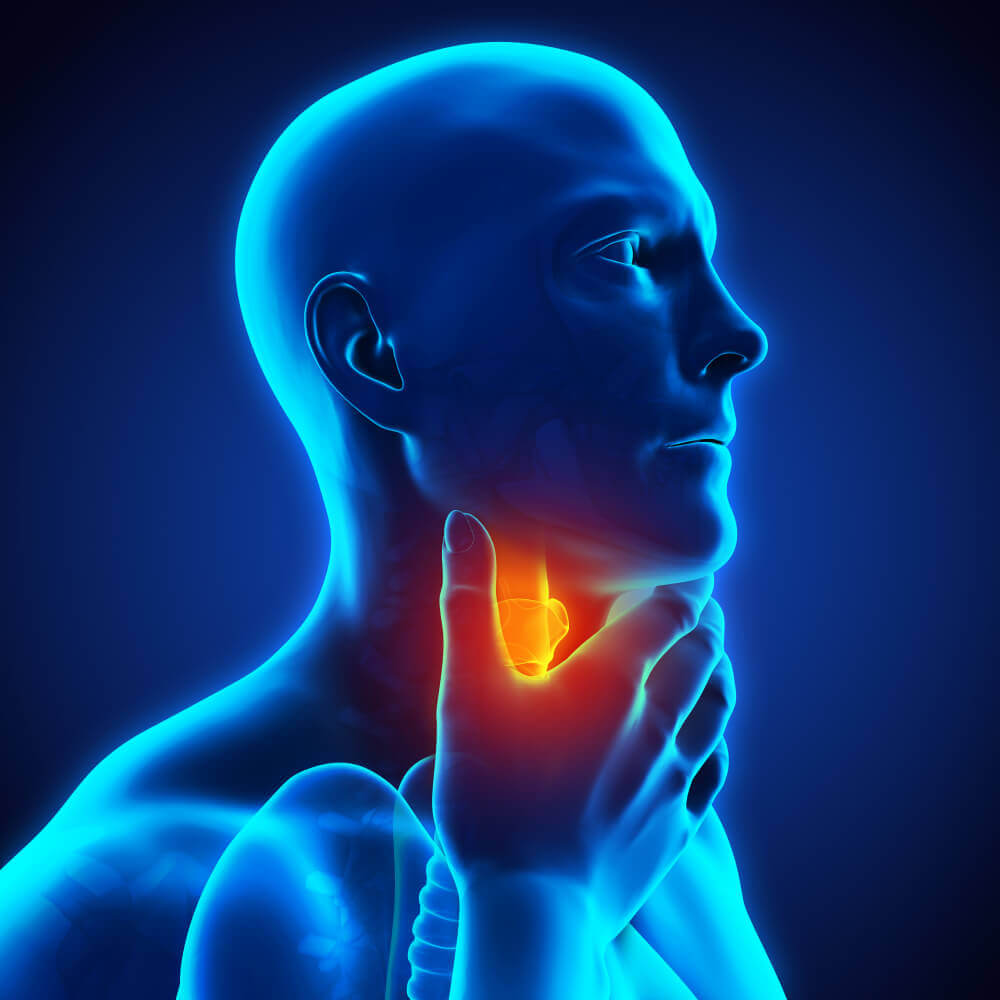What Is Pharyngitis?

Pharyngitis is the inflammation of the mucosa that lines the pharynx. It can be acute or chronic, the former being the most common form. Pharyngitis usually appears as a bad cold.
What is the pharynx and what does it do?
The pharynx is a hollow tube-shaped organ located inside the neck. It begins behind the nose and ends at the top of the windpipe and esophagus, which is the tube that goes to the stomach.
The pharynx is approximately 13 cm long (5 inches), but varies according to the size of the body. It’s made up of 3 parts, which are covered by a different mucosa. These parts are:
- Rhinopharynx: This originates from behind the nasal cavity, which is why it’s also called the nasopharynx. On both sides, it has a hole that brings the middle ear into contact with the lateral wall of the pharynx through the Eustachian tube.
- Oropharynx: Also known as the middle pharynx or oropharynx, it’s located in the mouth through the isthmus of fauces. Above, it connects to the soft palate and, below, to the epiglottis.
- Laryngopharynx: This includes the structures that surround the larynx below the epiglottis as far as the esophagus.
Among the main functions, the pharynx helps the swallowing mechanism, which is the passage of the food bolus from the mouth into the esophagus. It also takes part in breathing, phonation and hearing, as the auditory tube is next to it and they join through the Eustachian tube.
Causes of acute pharyngitis
Acute pharyngitis usually appears due to a viral or bacterial infection. However, fungi can also cause this infection. In 30% of cases, it isn’t possible to identify any pathogenic microorganism.
Most acute pharyngitis occurs during the cold months, that is, the season of infectious respiratory diseases, when transmission among family members is more common.
In both children and adults, most pharyngitis is viral. Among the viruses involved are those of the common cold, such as rhinovirus or adenovirus, as well as the influenza virus, and Ebstein-Barr, among others.
As for bacterial pharyngitis, they’re more frequent in children and, most of the time, they’re caused by a group A streptococcus. This type of infection is serious and complications that can occur include:
- Acute rheumatic fever
- Renal insufficiency
- Bacteremia
- Streptococcal toxic shock syndrome

Symptoms
Infants with acute pharyngitis may be irritable, and have sleeping and eating disorders. Also, other typical symptoms of this infection are irregular fever, clear or thick nasal mucus, and nasal obstruction.
As for children with acute pharyngitis, they usually have enlarged glands in the neck, which are usually painful. In addition, they may have:
- High fever
- Plates of whitish exudate on the tonsils or in the pharynx
- Painful and enlarged cervical nodes
Finally, the symptoms that adults suffer are similar to those of school-age children. This means that they usually suffer from fever, general malaise, redness of the pharynx, plaques on the tonsils, and pain in the throat that’s exacerbated when swallowing saliva, among others.
Diagnosis of acute pharyngitis
The diagnosis of acute pharyngitis is based on the medical history and examination of the patient. The more or less sudden presentation of the condition and its symptoms will make the doctor suspect an acute pharyngotonsillitis illness.
On many occasions, it’s useful to perform some laboratory tests, such as:
- Hemogram
- Erythrocyte sedimentation rate
- Determination of the level of antistreptolysins
If, in addition to these tests, an antibiogram is carried out, it’ll be possible to know the sensitivity of these germs to subsequent antibiotic treatment.
Treatment
There are a number of recommendations that must be carried out, regardless of the cause that triggers pharyngitis. Some of them are:
- Drinking plenty of water
- Maintaining a good diet
- Taking non-steroidal anti-inflammatory drugs (NSAIDs), such as ibuprofen. In cases where the condition is very serious, NSAIDs can be changed to corticosteroids.
General measures aside, such as an acute pharyngitis usually due to viral infections, antibiotic treatment isn’t effective. The use of antibiotics is reduced to bacterial infections, to complicated viral infections, or when a complication of a pharyngo-tonsillar condition appears.

On the other hand, we can mention that the use of oral mouthwashes with antiseptics can help reduce local symptoms.
Causes of chronic pharyngitis
Chronic pharyngitis causes inflammatory, irritative, or allergic modifications of the pharynx that are maintained over time. They don’t usually have an infectious origin, but are a consequence of prolonged exposure to a series of factors, such as:
- Irritants: Dust, chemicals, air conditioning, etc.
- Alcohol and/or tobacco abuse.
- Hormonal factors: Hypothyroidism or menopause, for example.
- Chronic diseases, such as diabetes and respiratory allergies.
- Abusive use of vasoconstrictor nasal drops.
In addition, depending on the causes that trigger this disease, it can be classified into chronic pharyngitis of the following types:
- Respiratory
- Digestive
- Allergic
- Metabolic
Symptoms
When defining the symptoms of chronic pharyngitis, it’s necessary to know which subtype the disease corresponds to. In this sense, we can observe the following symptoms depending on the type of pharyngitis:
- Simple: Irritating cough, a sensation of having a foreign object in the pharynx, discomfort when swallowing, redness in the area.
- Granulosa: All of the above symptoms occur, together with severe inflammation of the lymphatic tissue, which increases the sensation of having a foreign object in the throat. It’s also more difficult to swallow and the pain is stronger.
- Dry: The same as the previous two, but added to the list are atrophy of the pharyngeal mucosa, which becomes dry and shiny, and the appearance of viscous mucus on the pharyngeal tissues.
Diagnosis
The diagnosis of chronic pharyngitis, as in the case of acute pharyngitis, is based on the patient’s medical history, in addition to the physical examination.
Chronic symptoms and circumstances that worsen the condition make the doctor suspect the existence of this condition. In addition, there are some tests that are usually helpful in making a good diagnosis, cataloging the severity of the condition, and favoring the prevention of possible complications.
Treatment
In cases where the patient suffers from chronic pharyngitis that isn’t caused by an infectious agent, such as bacteria, treatments may include any of the following :
- Vitamin complexes
- Mucoregulators
- Ointments
- Nasal ointments
It’s also important to avoid environments that worsen the pharyngeal condition, such as fumes or very dry environments. If the disease can’t be controlled or serious complications have occurred, then surgical treatment may be required.
Pharyngitis is the inflammation of the mucosa that lines the pharynx. It can be acute or chronic, the former being the most common form. Pharyngitis usually appears as a bad cold.
What is the pharynx and what does it do?
The pharynx is a hollow tube-shaped organ located inside the neck. It begins behind the nose and ends at the top of the windpipe and esophagus, which is the tube that goes to the stomach.
The pharynx is approximately 13 cm long (5 inches), but varies according to the size of the body. It’s made up of 3 parts, which are covered by a different mucosa. These parts are:
- Rhinopharynx: This originates from behind the nasal cavity, which is why it’s also called the nasopharynx. On both sides, it has a hole that brings the middle ear into contact with the lateral wall of the pharynx through the Eustachian tube.
- Oropharynx: Also known as the middle pharynx or oropharynx, it’s located in the mouth through the isthmus of fauces. Above, it connects to the soft palate and, below, to the epiglottis.
- Laryngopharynx: This includes the structures that surround the larynx below the epiglottis as far as the esophagus.
Among the main functions, the pharynx helps the swallowing mechanism, which is the passage of the food bolus from the mouth into the esophagus. It also takes part in breathing, phonation and hearing, as the auditory tube is next to it and they join through the Eustachian tube.
Causes of acute pharyngitis
Acute pharyngitis usually appears due to a viral or bacterial infection. However, fungi can also cause this infection. In 30% of cases, it isn’t possible to identify any pathogenic microorganism.
Most acute pharyngitis occurs during the cold months, that is, the season of infectious respiratory diseases, when transmission among family members is more common.
In both children and adults, most pharyngitis is viral. Among the viruses involved are those of the common cold, such as rhinovirus or adenovirus, as well as the influenza virus, and Ebstein-Barr, among others.
As for bacterial pharyngitis, they’re more frequent in children and, most of the time, they’re caused by a group A streptococcus. This type of infection is serious and complications that can occur include:
- Acute rheumatic fever
- Renal insufficiency
- Bacteremia
- Streptococcal toxic shock syndrome

Symptoms
Infants with acute pharyngitis may be irritable, and have sleeping and eating disorders. Also, other typical symptoms of this infection are irregular fever, clear or thick nasal mucus, and nasal obstruction.
As for children with acute pharyngitis, they usually have enlarged glands in the neck, which are usually painful. In addition, they may have:
- High fever
- Plates of whitish exudate on the tonsils or in the pharynx
- Painful and enlarged cervical nodes
Finally, the symptoms that adults suffer are similar to those of school-age children. This means that they usually suffer from fever, general malaise, redness of the pharynx, plaques on the tonsils, and pain in the throat that’s exacerbated when swallowing saliva, among others.
Diagnosis of acute pharyngitis
The diagnosis of acute pharyngitis is based on the medical history and examination of the patient. The more or less sudden presentation of the condition and its symptoms will make the doctor suspect an acute pharyngotonsillitis illness.
On many occasions, it’s useful to perform some laboratory tests, such as:
- Hemogram
- Erythrocyte sedimentation rate
- Determination of the level of antistreptolysins
If, in addition to these tests, an antibiogram is carried out, it’ll be possible to know the sensitivity of these germs to subsequent antibiotic treatment.
Treatment
There are a number of recommendations that must be carried out, regardless of the cause that triggers pharyngitis. Some of them are:
- Drinking plenty of water
- Maintaining a good diet
- Taking non-steroidal anti-inflammatory drugs (NSAIDs), such as ibuprofen. In cases where the condition is very serious, NSAIDs can be changed to corticosteroids.
General measures aside, such as an acute pharyngitis usually due to viral infections, antibiotic treatment isn’t effective. The use of antibiotics is reduced to bacterial infections, to complicated viral infections, or when a complication of a pharyngo-tonsillar condition appears.

On the other hand, we can mention that the use of oral mouthwashes with antiseptics can help reduce local symptoms.
Causes of chronic pharyngitis
Chronic pharyngitis causes inflammatory, irritative, or allergic modifications of the pharynx that are maintained over time. They don’t usually have an infectious origin, but are a consequence of prolonged exposure to a series of factors, such as:
- Irritants: Dust, chemicals, air conditioning, etc.
- Alcohol and/or tobacco abuse.
- Hormonal factors: Hypothyroidism or menopause, for example.
- Chronic diseases, such as diabetes and respiratory allergies.
- Abusive use of vasoconstrictor nasal drops.
In addition, depending on the causes that trigger this disease, it can be classified into chronic pharyngitis of the following types:
- Respiratory
- Digestive
- Allergic
- Metabolic
Symptoms
When defining the symptoms of chronic pharyngitis, it’s necessary to know which subtype the disease corresponds to. In this sense, we can observe the following symptoms depending on the type of pharyngitis:
- Simple: Irritating cough, a sensation of having a foreign object in the pharynx, discomfort when swallowing, redness in the area.
- Granulosa: All of the above symptoms occur, together with severe inflammation of the lymphatic tissue, which increases the sensation of having a foreign object in the throat. It’s also more difficult to swallow and the pain is stronger.
- Dry: The same as the previous two, but added to the list are atrophy of the pharyngeal mucosa, which becomes dry and shiny, and the appearance of viscous mucus on the pharyngeal tissues.
Diagnosis
The diagnosis of chronic pharyngitis, as in the case of acute pharyngitis, is based on the patient’s medical history, in addition to the physical examination.
Chronic symptoms and circumstances that worsen the condition make the doctor suspect the existence of this condition. In addition, there are some tests that are usually helpful in making a good diagnosis, cataloging the severity of the condition, and favoring the prevention of possible complications.
Treatment
In cases where the patient suffers from chronic pharyngitis that isn’t caused by an infectious agent, such as bacteria, treatments may include any of the following :
- Vitamin complexes
- Mucoregulators
- Ointments
- Nasal ointments
It’s also important to avoid environments that worsen the pharyngeal condition, such as fumes or very dry environments. If the disease can’t be controlled or serious complications have occurred, then surgical treatment may be required.
- Gallach Patau, M., & Gascon Lecha, M. P. (1994). FARINGITIS. Circular Farmaceutica.
- Tanz, R. R. (2016). Faringitis aguda. In Nelson. Tratado de pediatría.
- Vazel, L., Martins, C., Potard, G., & Marianowski, R. (2012). Faringitis crónicas. EMC – Otorrinolaringología. https://doi.org/10.1016/s1632-3475(05)43471-2
Este texto se ofrece únicamente con propósitos informativos y no reemplaza la consulta con un profesional. Ante dudas, consulta a tu especialista.







